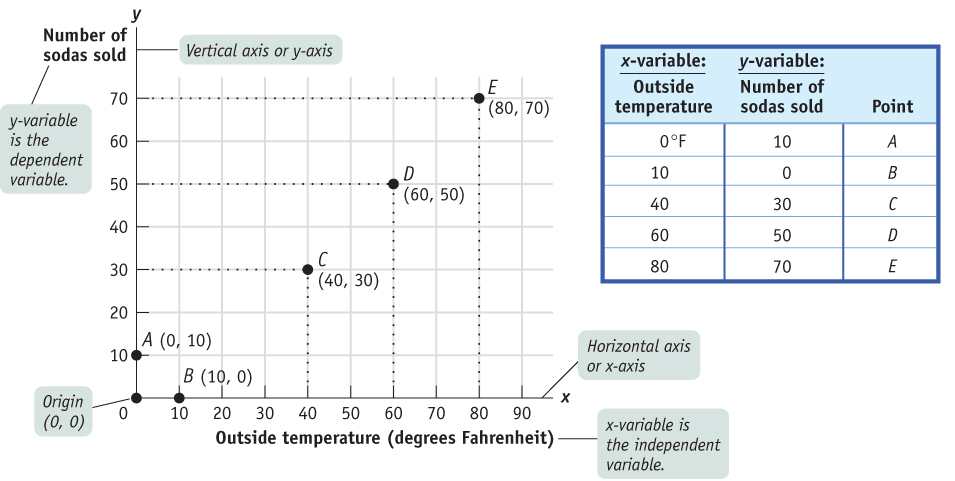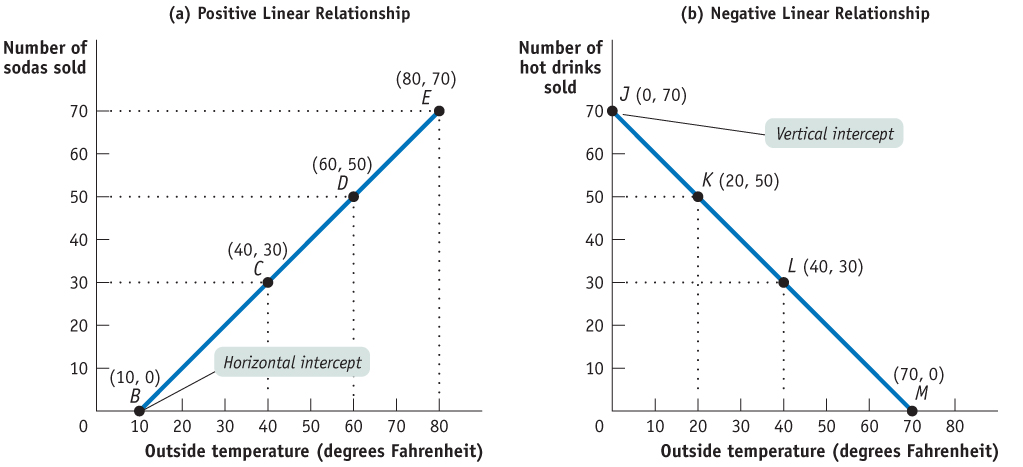How Graphs Work
Most graphs in economics are based on a grid built around two perpendicular lines that show the values of two variables, helping you visualize the relationship between them. So a first step in understanding the use of such graphs is to see how this system works.
Two-Variable Graphs
Figure A.1 shows a typical two-
| Figure A.1 | Plotting Points on a Two- |

The solid horizontal line on a graph is called the horizontal axis or x-
The solid vertical line on a graph is called the vertical axis or y-
The two axes meet at the origin.
Now let’s turn to graphing the data in this table. In any two-
You can plot each of the five points A through E on this graph by using a pair of numbers—
Looking at point A and point B in Figure A.1, you can see that when one of the variables for a point has a value of zero, it will lie on one of the axes. If the value of the x-variable is zero, the point will lie on the vertical axis, like point A. If the value of the y-variable is zero, the point will lie on the horizontal axis, like point B. (The location of point B was chosen to illustrate this fact and not because soda sales will really decrease when the temperature rises.)
A causal relationship is one in which the value taken by one variable directly influences or determines the value taken by the other variable.
In a causal relationship, the determining variable is called the independent variable and the determined variable is called the dependent variable.
Most graphs that depict relationships between two economic variables represent a causal relationship, a relationship in which the value taken by one variable directly influences or determines the value taken by the other variable. In a causal relationship, the determining variable is called the independent variable; the variable it determines is called the dependent variable. In our example of soda sales, the outside temperature is the independent variable. It directly influences the number of sodas that are sold, which is the dependent variable in this case.
By convention, we put the independent variable on the horizontal axis and the dependent variable on the vertical axis. Figure A.1 is constructed consistent with this convention: the independent variable (outside temperature) is on the horizontal axis and the dependent variable (number of sodas sold) is on the vertical axis. An important exception to this convention is in graphs showing the economic relationship between the price of a product and quantity of the product: although price is generally the independent variable that determines quantity, it is always measured on the vertical axis.
Curves on a Graph
A line on a graph is called a curve, regardless of whether it is a straight line or a curved line.
If a curve that shows the relationship between two variables is a straight line, or linear, the variables have a linear relationship.
When a curve is not a straight line, or nonlinear, the variables have a nonlinear relationship.
Panel (a) of Figure A.2 contains some of the same information as Figure A.1, with a line drawn through the points B, C, D, and E. Such a line on a graph is called a curve, regardless of whether it is a straight line or a curved line. If the curve that shows the relationship between two variables is a straight line, or linear, the variables have a linear relationship. When the curve is not a straight line, or nonlinear, the variables have a nonlinear relationship.
| Figure A.2 | Drawing Curves |

A point on a curve indicates the value of the y-variable for a specific value of the x-variable. For example, point D indicates that at a temperature of 60°F, a vendor can expect to sell 50 sodas. The shape and orientation of a curve reveal the general nature of the relationship between the two variables. The upward tilt of the curve in panel (a) of Figure A.2 suggests that vendors can expect to sell more sodas at higher outside temperatures.
When an increase in one variable is associated with an increase in the other variable, the variables are said to have a positive relationship.
When variables are related in this way—
When an increase in one variable is associated with a decrease in the other variable, the two variables are said to have a negative relationship.
When an increase in one variable is associated with a decrease in the other variable, the two variables are said to have a negative relationship. It is illustrated by a curve that slopes downward from left to right, like the curve in panel (b) of Figure A.2. Because this curve is also linear, the relationship it depicts is a negative linear relationship. Two variables that might have such a relationship are the outside temperature and the number of hot drinks a vendor can expect to sell at a baseball stadium.
The horizontal intercept indicates the value of the x-variable when the value of the y-variable is zero.
The vertical intercept indicates the value of the y-variable when the value of the x-variable is zero.
Return for a moment to the curve in panel (a) of Figure A.2, and you can see that it hits the horizontal axis at point B. This point, known as the horizontal intercept, shows the value of the x-variable when the value of the y-variable is zero. In panel (b) of Figure A.2, the curve hits the vertical axis at point J. This point, called the vertical intercept, indicates the value of the y-variable when the value of the x-variable is zero.